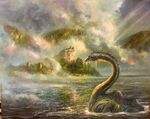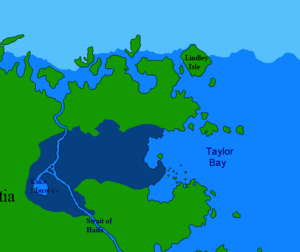Loch ell: Difference between revisions
No edit summary |
No edit summary |
||
| (One intermediate revision by one other user not shown) | |||
| Line 11: | Line 11: | ||
|locale = {{team flag|Moorland}}, {{team flag|Imperial Federation}}, {{team flag|Bassaridia Vaeringheim}} | |locale = {{team flag|Moorland}}, {{team flag|Imperial Federation}}, {{team flag|Bassaridia Vaeringheim}} | ||
|related = None | |related = None | ||
|danger = | |danger = Endangered | ||
}} | }} | ||
The '''loch ell''', also called a '''loch eel''', is a species of reptile native to the lochs (lakes) of [[Burwood]], in [[Moorland]]. Believed to be a remnant species from the dinosaur age of Micras, scientists think that a small number of loch ell survived in the isolated lochs of Burwood following the last ice age when the glaciers retreated from the region. They have a slow metabolism and a low fecundity, so the species did not spread as rapidly as more modern animals. In fact, the species was first only noted to exist in Loch Eve, and was a well-known folktale of the region for many years. The Loch Eve Monster was a superstitious tale that frightened children and emptied the pockets of tourists. But in 1699 Sir Drummond Scott led an expedition into the loch and managed to catch a specimen of this elusive species. Other sightings and a more intense study of the species followed, confirming a small-yet-thriving population. Other pockets of loch ells were discovered along larger rivers and lochs leading to the [[Strait of Haifa]], which is already well-known for its [[Flora and fauna of the Strait of Haifa|bizarre flora and fauna]]. Small populations have been documented as far west as [[Lake Morovia]]. It has since been hypothesized that the strait itself is a holdover from prehistoric times, with the loch ells being an offshoot of that. | The '''loch ell''', also called a '''loch eel''', is a species of reptile native to the lochs (lakes) of [[Burwood]], in [[Moorland]]. Believed to be a remnant species from the dinosaur age of Micras, scientists think that a small number of loch ell survived in the isolated lochs of Burwood following the last ice age when the glaciers retreated from the region. They have a slow metabolism and a low fecundity, so the species did not spread as rapidly as more modern animals. In fact, the species was first only noted to exist in Loch Eve, and was a well-known folktale of the region for many years. The Loch Eve Monster was a superstitious tale that frightened children and emptied the pockets of tourists. But in 1699 Sir Drummond Scott led an expedition into the loch and managed to catch a specimen of this elusive species. Other sightings and a more intense study of the species followed, confirming a small-yet-thriving population. Other pockets of loch ells were discovered along larger rivers and lochs leading to the [[Strait of Haifa]], which is already well-known for its [[Flora and fauna of the Strait of Haifa|bizarre flora and fauna]]. Small populations have been documented as far west as [[Lake Morovia]]. It has since been hypothesized that the strait itself is a holdover from prehistoric times, with the loch ells being an offshoot of that. Ecologists estimate the global population to be less than 10,000, making them a rare and endangered species. | ||
The loch ells have short narrow skulls on long necks. The teeth of Plesiosaurus are "simple, needle-like cones" that are "slightly curved and circular in transverse section". They are sharply pointed with fine striations running from tip to base, and point forward (procumbent). Plesiosaurus was a moderately sized plesiosaur that grew to 2.87–3.5 m (9.4–11.5 ft) in length. There are approximately 40 cervical vertebrae (neck vertebrae), with different specimens preserving 38 to 42 cervical vertebrae. Ribs are found from the neck to the tail. Cervical ribs are hatchet-shaped and have two articular heads. Plesiosaurus also has gastralia, also known as "belly ribs." Nine or more sets of gastralia are present between the shoulder and pelvis. Each set is composed of seven elements: a bone on the midline flanked by three lateral elements. | The loch ells have short narrow skulls on long necks. The teeth of Plesiosaurus are "simple, needle-like cones" that are "slightly curved and circular in transverse section". They are sharply pointed with fine striations running from tip to base, and point forward (procumbent). Plesiosaurus was a moderately sized plesiosaur that grew to 2.87–3.5 m (9.4–11.5 ft) in length. There are approximately 40 cervical vertebrae (neck vertebrae), with different specimens preserving 38 to 42 cervical vertebrae. Ribs are found from the neck to the tail. Cervical ribs are hatchet-shaped and have two articular heads. Plesiosaurus also has gastralia, also known as "belly ribs." Nine or more sets of gastralia are present between the shoulder and pelvis. Each set is composed of seven elements: a bone on the midline flanked by three lateral elements. | ||
Latest revision as of 13:44, 20 November 2024
Scientific Name: Plesiosaurus lochodeirus  |
|
Physical Description Body Type: Reptilia Biological Information Diet: Carnivorous |
The loch ell, also called a loch eel, is a species of reptile native to the lochs (lakes) of Burwood, in Moorland. Believed to be a remnant species from the dinosaur age of Micras, scientists think that a small number of loch ell survived in the isolated lochs of Burwood following the last ice age when the glaciers retreated from the region. They have a slow metabolism and a low fecundity, so the species did not spread as rapidly as more modern animals. In fact, the species was first only noted to exist in Loch Eve, and was a well-known folktale of the region for many years. The Loch Eve Monster was a superstitious tale that frightened children and emptied the pockets of tourists. But in 1699 Sir Drummond Scott led an expedition into the loch and managed to catch a specimen of this elusive species. Other sightings and a more intense study of the species followed, confirming a small-yet-thriving population. Other pockets of loch ells were discovered along larger rivers and lochs leading to the Strait of Haifa, which is already well-known for its bizarre flora and fauna. Small populations have been documented as far west as Lake Morovia. It has since been hypothesized that the strait itself is a holdover from prehistoric times, with the loch ells being an offshoot of that. Ecologists estimate the global population to be less than 10,000, making them a rare and endangered species.
The loch ells have short narrow skulls on long necks. The teeth of Plesiosaurus are "simple, needle-like cones" that are "slightly curved and circular in transverse section". They are sharply pointed with fine striations running from tip to base, and point forward (procumbent). Plesiosaurus was a moderately sized plesiosaur that grew to 2.87–3.5 m (9.4–11.5 ft) in length. There are approximately 40 cervical vertebrae (neck vertebrae), with different specimens preserving 38 to 42 cervical vertebrae. Ribs are found from the neck to the tail. Cervical ribs are hatchet-shaped and have two articular heads. Plesiosaurus also has gastralia, also known as "belly ribs." Nine or more sets of gastralia are present between the shoulder and pelvis. Each set is composed of seven elements: a bone on the midline flanked by three lateral elements.
The shoulder girdle is only partly known but appears to be typical for plesiosaurs. It includes fused clavicles at the anterior end, scapulae (shoulder blades), and large coracoids. The scapulae and coracoids both contribute to the glenoids (arm sockets). A pair of oval holes called pectoral fenestrae are found midway along the scapular/coracoid contacts.[16] The forelimbs are elongate and relatively narrow compared to those of most plesiosaurs. The humerus (upper arm bone) has distinctive curvature, which appears to be a retained primitive feature among sauropterygians. Mature Plesiosaurus also have a distinctive groove along the ventral surface of the humerus. The forearm includes a flat, broad, crescent-shaped ulna and a "robust and pillar-like" radius. The wrist includes six bones. The hand paddle has five digits; the phalangeal formula is uncertain, but the count for one large individual, from "thumb" to fifth "finger", is 4-8-9-8-6.
The pelvis includes equant pubic bones, ischia, and blade-shaped ilia connecting the pelvis to the vertebral column. The acetabulum is formed by surfaces on the pubic bones and ischia. Similar to the pectoral girdle, there is a pair of holes between the ischia and pubic bones.[18] The hindlimbs are long and narrow, and in adults, they are much smaller than the forelimbs. The thigh bones are straight. The lower hindlimb includes two roughly equal-sized bones, the robust tibia and the semilunate-shaped fibula. There are six bones in the ankle. The foot paddle includes five digits. Like the hand, the phalangeal formula is uncertain, but is at least 3-7-9-8-7 from innermost to outer "toe".
Plesiosaurus feed mainly on clams and snails, including fish and other prey as well. Its U-shaped jaw and sharp teeth is used like a fish trap. They propel themselves by the paddles, the tail being too short to be of much use. The neck is used as a rudder when navigating during a chase. Plesiosaurus give live birth to live young in the water like most sea snakes. The young live mostly in estuaries before moving out into the open water.
